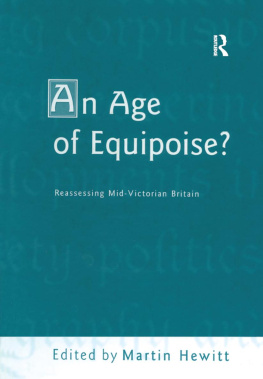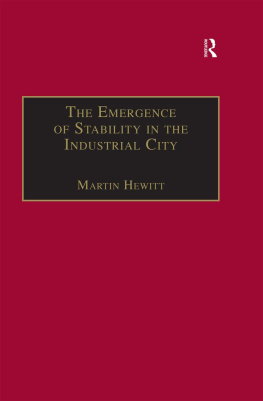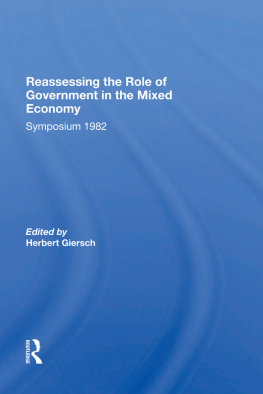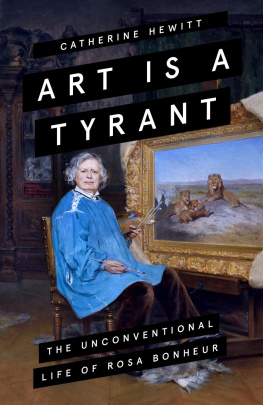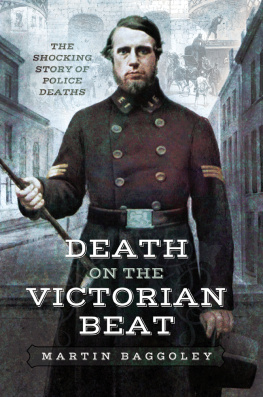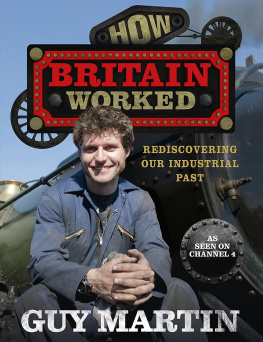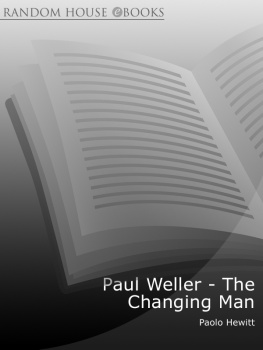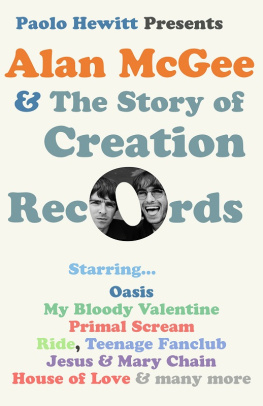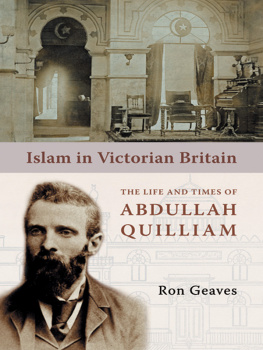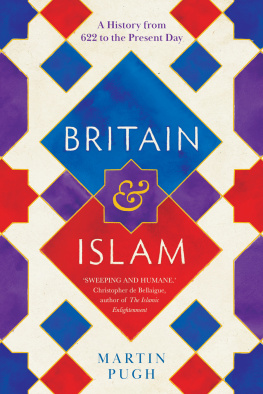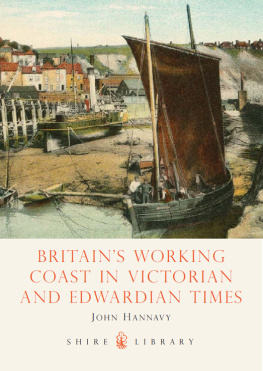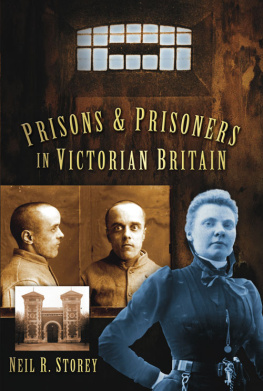An Age of Equipoise?
An Age of Equipoise?
Reassessing Mid-Victorian Britain
Edited by
MARTIN HEWITT
First published 2000 by Ashgate Publishing
Published 2017 by Routledge
2 Park Square, Milton Park, Abingdon, Oxon OX14 4RN
711 Third Avenue, New York, NY 10017, USA
Routledge is an imprint of the Taylor & Francis Group, an informa business
Copyright Martin Hewitt and the contributors, 2000
The authors have asserted their moral right under the Copyright, Designs and Patents Act, 1988, to be identified as the authors of this work.
All rights reserved. No part of this book may be reprinted or reproduced or utilised in any form or by any electronic, mechanical, or other means, now known or hereafter invented, including photocopying and recording, or in any information storage or retrieval system, without permission in writing from the publishers.
Notice:
Product or corporate names may be trademarks or registered trademarks, and are used only for identification and explanation without intent to infringe.
British Library Cataloguing in Publication Data
An Age of Equipoise? Reassessing Mid-Victorian Britain.
1. Great BritainSocial life and customs19th century. 2. Great BritainSocial conditions19th century. 3. Great BritainIntellectual life19th century.
I. Hewitt, Martin.
941.081
Library of Congress Cataloging-in-Publication Data
An age of equipoise? Reassessing mid-Victorian Britain/edited by Martin Hewitt.
p. cm.
Includes bibliographical references and index.
ISBN 0-7546-0257-5 (alk. paper)
1. Great BritainHistoryVictoria, 18371901. 2. Great BritainCivilization19th century. 3. Burn, William Laurence. Age of Equipoise. I. Hewitt, Martin.
DA550.A35 2000
941.081dc21
00-57605
ISBN 13: 978-0-7546-0257-6 (hbk)
Typeset in Sabon by Manton Typesetters, Louth, Lincolnshire
Contents
Martin Hewitt
Peter H. Hoffenberg
Tim Barringer
Sheila Sullivan
Roland Quinault
David Brown
Martin J. Wiener
Stephen L. Keck
Matthew Cragoe
Brenda Assael
Ross G. Forman
Brenda Assael is a lecturer in Modern Britain in the History Department of the University of Wales, Swansea. Her forthcoming book, The Circus and Victorian Society, will be published by the University Press of Virginia. She has also written numerous entries for the New Dictionary of National Biography on Victorian performers and her essay on Theatre History appears in the Encyclopedia of Historians and Historical Writing, edited by Kelly Boyd.
Tim Barringer is Assistant Professor in the Department of History of Art at Yale University. He has written widely on nineteenth-century visual culture. He is co-editor of Colonialism and the Object (with Tom Flynn, 1998) and Frederic Leighton: Antiquity, Renaissance, Modernity (with Elizabeth Prettejohn, 1999) and is author of Reading the Pre-Raphaelites (1999).
David Brown is a field co-ordinator for History at City College, Norwich. With the help of a British Academy award, he is completing research on the subject of New men of wealth and the purchase of land in the United Kingdom 17801879.
Matthew Cragoe is a senior lecturer in History at the University of Hertfordshire. He is the author of An Anglican Aristocracy: the Moral Economy of the Landed Estate in Carmarthenshire 183295 (OUP, 1996) and has published widely on the history of Victorian Wales. He is currently writing a political history of the principality during the nineteenth century.
Ross G. Forman is a research fellow in English at Kingston University (UK). His work focuses on nineteenth-century British imperialism in Latin America and China. He is currently completing a book manuscript on Victorian and Edwardian images of China.
Martin Hewitt is Director of the Leeds Centre for Victorian Studies and editor of the Journal of Victorian Culture. Along with Robert Poole he has recently produced an edition of The Diaries of Samuel Bamford, 185861 (Sutton, 2000).
Peter H. Hoffenberg (PhD, University of California, Berkeley) is Associate Professor of History at the University of Hawaii, Manoa. He is the author of An Empire on Display: English, Indian and Australian Exhibitions from the Crystal Palace to the Great War, forthcoming from the University of California Press. His work also includes the study of nineteenth- and twentieth-century Australian political culture and the life and times of John Lockwood Kipling, artist and art-school administrator.
Stephen L. Keck is currently working on projects which involve both Ruskin and Helps. Having taught at the College of Charleston (USA), he is currently Assistant Professor of History at the National University of Singapore.
Roland Quinault teaches modern British history at the University of North London. He has published extensively on Victorian political and social history and is currently writing a book on prime ministers and democracy. He was formerly Honorary Secretary of the Royal Historical Society.
Sheila Sullivan received her PhD in English from the University of Chicago in 1995 and teaches at St Marys College of Maryland. She has written articles on late Victorian masculinity (Sherlock Holmes), Newgate fiction, illustrated journalism, Victorian scandal (the Road Murder and The Woman in White) and Madeleine Smith. She is completing a book tentatively titled Authorizing Gestures: Gender, Criminality and the Creation of Professional Authority in the 1860s. She is also working with a collaborator on a book of essays: The Function of the Courtroom at the Present Time: Rereading the English Trial (18401920).
Martin J. Wiener, Mary Gibbs Jones Professor of History at Rice University, is the author of Between Two Worlds: The Political Thought of Graham Wallas (1971), English Culture and the Decline of the Industrial Spirit, 18501980 (1981) and Reconstructing the Criminal: Culture, Law and Policy in England 18301914 (1990). He has recently published in the Journal of British Studies, the Journal of Modern History, Social History and Law and History Review. The essay here is part of a book project on the role of law in reconstructing manliness in nineteenth-century Britain.
Martin Hewitt
a fair appraisal of the Victorian commonwealth demands a knowledge of historiography as well as of history
Asa Briggs, Age of Improvement (1959)
W.L. Burns The Age of Equipoise is one of those books that have attained classic status. Few serious students of mid-nineteenth-century Britain can be unaware of the book and its characterization of the period. In print at least until the later 1970s, it was for the twenty or twenty-five years after its publication in 1964 a virtually ubiquitous presence on the bibliographies and lists of recommended reading for the period. Of course, G.M. Youngs Victorian England: Portrait of an Age (1936) remained and in many respects remains unassailable as the fundamental interpretation of the Victorian era; but Burns book was usually the proxime accessit, showered with praise by subsequent scholars as indispensable for an understanding of the cross-currents and anomalies of mid-Victorian society, and perhaps the best general study of mid-Victorian life in every aspect.1


